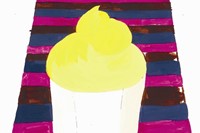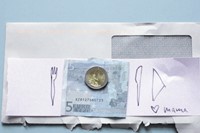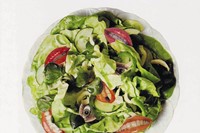Art collector Valeria Napoleone has been nurturing artists – financially and otherwise - since the mid-1990s when, after completing a degree in Arts Administration from New York’s Fashion Institute of Technology, she sought out artist communities in
Art collector Valeria Napoleone has been nurturing artists – financially and otherwise - since the mid-1990s when, after completing a degree in Arts Administration from New York’s Fashion Institute of Technology, she sought out artist communities in Williamsburg and immersed herself in their lives. Opposed to solely buying art (“from the first work I knew that I would be starting a collection”) Napoleone would also find herself cooking for the artists she befriended at ad-hoc gallery spaces. The dinners that Napoleone hosts nowadays may be more formal affairs, from the dining room of her stately Kensington residence, but the traditional Northern Italian dishes she prepares have continued to impress her guests, to the extent that one them – artist Delia Brown – suggested publishing their recipes. Collaborating with the highly inventive Koenig Books, Napoleone’s collection of Exquisite Recipes has finally been released, and not only shares a wide range of previously-secret family specials – from Cotechino sausage in pastry, spinach roulade, and buttered peas with ham, to the properly sweet stuff (carnival fritters, deep-fried egg custard, orange cheesecake and tiramisu) – but also shows off rare works by some of Napoleone’s favourite artists who were asked to present pieces that they personally felt related to her project. Artistic treats include Goshka Macuga's pin-up food posters (2009), Pamela Fraser's cheerful and innocent gouache Magenta Stripe Zabaione (2009), photomontage and collage works from the late '70s by Linder (Salad from 1977 is a particular eye opener), Monika Baer's evocative photographic love letter of sorts (Untitled 2012) and Sue Tompkins melodic verse about the joys of eating and cooking (Cooking Love 2010).
What kind of status symbol do you think collecting art is?
Of course there is that trophy element, as though it is some kind of accessory – particularly for new buyers. It's a point of conversation, and it's really fashionable. For others it's simply an investment. For me, of course, it's my passion and a lifestyle. Every day I'm out visiting galleries and studios, committing myself to a dialogue with these people.
You only collect female artists – why did you decide to do this?
It just came to me. During the 90s in New York I was seeing work by people like Barbara Kruger and Cindy Sherman, and women weren't as represented in museums and galleries. I was touched by these artists and I thought there was a strong discrimination against women at this time. But it wasn't because I felt sorry for them or anything like that. I just thought 'I don't know anybody else who is doing it', and I suppose sometimes things come to you without any rationality or coherence.
An artist you collect, Delia Brown, was the initiator for this book...
She stayed with me during the Frieze art fair a while ago and I cooked for her during that time. She tasted my food and at the end of the week she said I had to do a cookbook. I then thought about how artists I collect could contribute to it, and I asked them to think about what comes to their mind when they think of food.
"I thought there was a strong discrimination against women at this time...it wasn't because I felt sorry for them or anything like that. I just thought 'I don't know anybody else who is doing it'..."
What is the purpose of your dinners?
They're mainly to help the artists. My dinners have a goal – they are to connect people, in particular the artist with curators and collectors. The more eclectic the selection of people, the better. When I'm thinking about the guestlist I work out which people will be helpful to the artist. As these dinners have a purpose I'm very specific about who I invite.
What characteristics make the perfect host?
I give warmth and hospitality. I want people to feel at ease, and if you are really genuine, people relax. It’s about the energy of the host. My father always told me ‘Never, ever leave people without wine’.
Which dishes will you be offering at your forthcoming dinners this autumn?
I’ll be making a polenta with lentils and bruschetta. I always have lots of vegetable dishes – lasagne with pesto, risotto. I always have a desert table as well, serving around eight to ten deserts and chocolate plates. Not pralines, but small mars bars! It’s a nice way to end the evening.
What are your favourite restaurants in London?
Assaggi in Notting Hill is like my second home. They do great Sardinian food. I also really adore Roka. Mr. Chow has a nice, relaxed ambiance, and I like its 80s look!
Valeria Napoleone’s Catalogue of Exquisite Recipes is published by Koenig Books, with a portion of the profits being donated to Down Syndrome Education International.
Text by Allie Biswas



